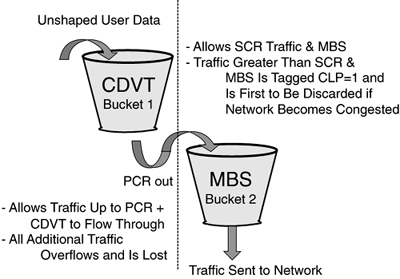ATM Traffic Contract Parameters
Before ATM data traffic can be sent across the network, the customer and NSP must agree on traffic characteristics and on the kind of service the network is to deliver. This agreement, called the traffic contract, consists of four parts:
Source traffic descriptor Uses four attributes to describe user traffic: peak cell rate (PCR), sustainable cell rate (SCR), maximum burst size (MBS), and minimum cell rate (MCR).
Conformance definition Defines which traffic the network will accept at what rate and at what burstiness (traffic in excess of subscribed average) a user is allowed to send traffic.
Cell Delay Variation Tolerance (CDVT) Is a safety margin that absorbs delay variations in premises equipment.
Quality-of-Service (QoS) parameters Must be guaranteed by the network. The following are examples of Quality-of-Service parameters:
- - Cell Transfer Delay (CTD) CTD is the delay experienced by a cell between network entry and exit points. CTD includes network propagation delays, queuing delays at various intermediate switches, and service times at queuing points.
- - Cell Delay Variation (CDV) A measure of the variance of the CTD. High variation implies larger buffering for delay-sensitive traffic such as voice and video.
- - Cell Loss Ratio (CLR) The percentage of cells not delivered at their destination because they were lost in the network, often because of network congestion or buffer overflow.
- - Cell Transfer Delay (CTD) CTD is the delay experienced by a cell between network entry and exit points. CTD includes network propagation delays, queuing delays at various intermediate switches, and service times at queuing points.
ATM Service Classes use one or more of the following service parameters, depending on the CoS implemented, such as Constant Bit Rate (CBR) or Variable Bit Rate-Real Time (VBRrt):
Peak Cell Rate (PCR) The maximum bit rate that can be transmitted.
Sustainable Cell Rate (SCR) The upper limit for the average cell rate that can be transmitted.
Maximum Burst Size (MBS)/Burst Tolerance (BT) The maximum number of cells the source can transmit at the PCR.
Minimum Cell Rate (MCR) The minimum cell rate guaranteed by the ATM network.
These traffic parameters combine in specific combinations to provide a QoS to the network customer.
Technical Note: Leaky BucketLeaky Bucket is an informal term for the Generic Cell Rate Algorithm (GCRA). The concept behind the Leaky Bucket/GCRA is that there is a finite queue serving as a door between the sending host and the ATM network. When the host wants to send an ATM cell, the cell must go through the door, which resembles a bucket with a hole in the bottom (the "leaky bucket"). This "bucket" holds as many cells to be transmitted as it can until it overflows. The bucket will transmit cells from the leakage at a constant rate with the overflow cells being discarded. The Dual Leaky Bucket operation is described as follows:
The Dual Leaky Bucket is illustrated in Figure 9-5. Figure 9-5. Dual "Leaky Bucket"
|
EAN: 2147483647
Pages: 269
